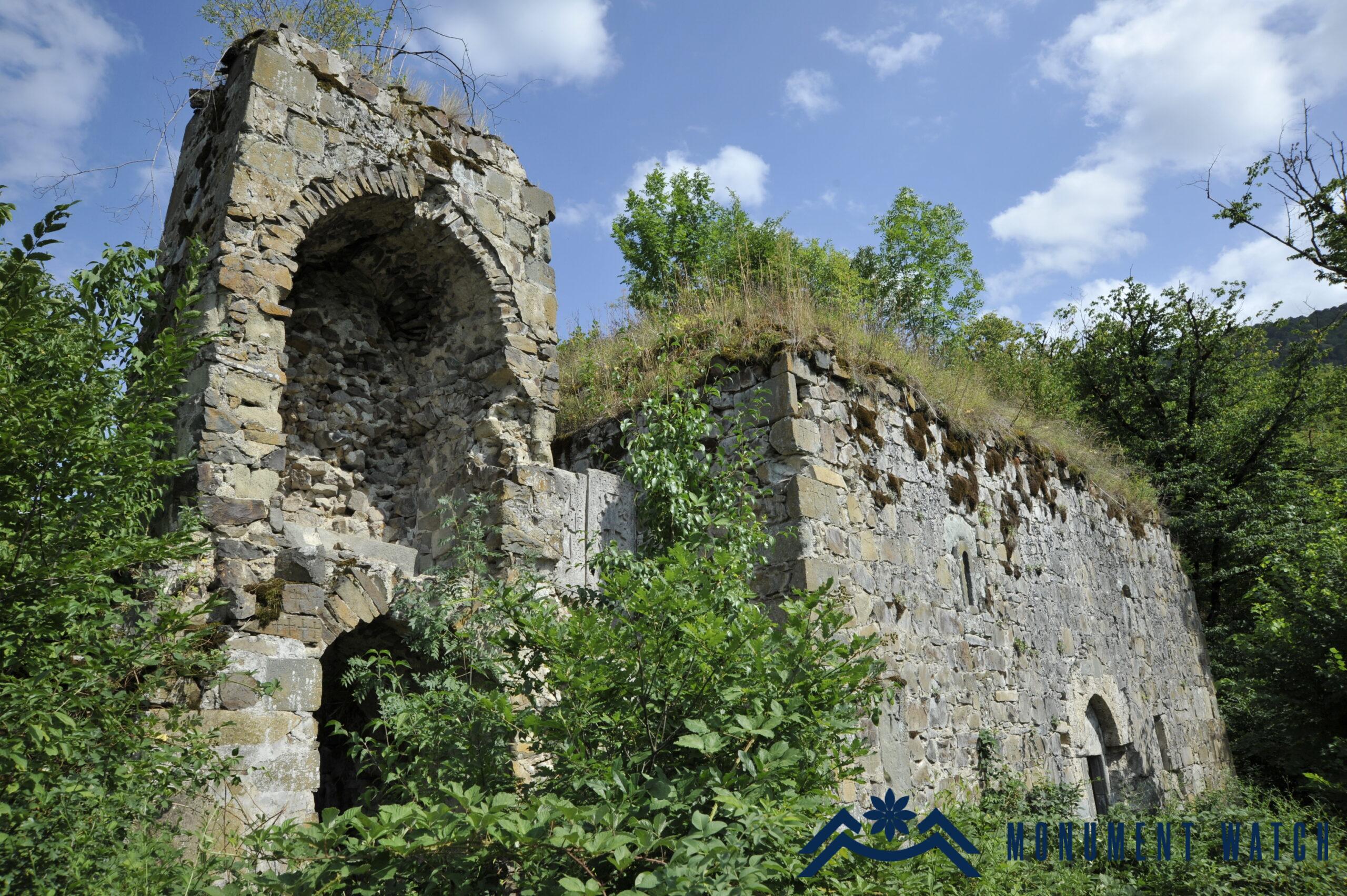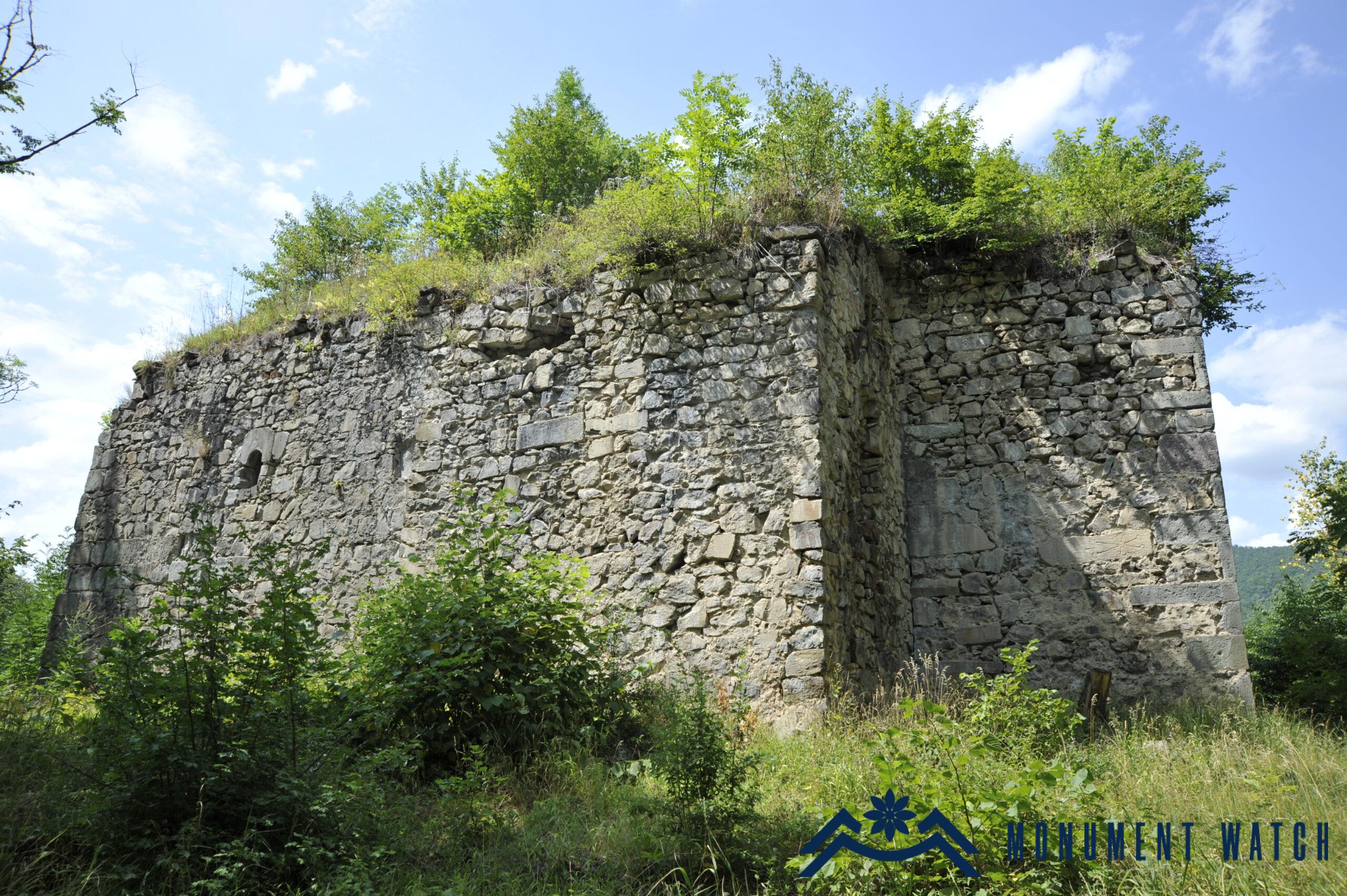The Khadar (Khatravank) Monastery: general information
Location
The Khadar monastery is situated west of Vaghuhas village in the Martakert region of the Republic of Artsakh, atop a wooded plateau that is challenging to reach. It sits on the right bank of the Tartar River, with the river flowing at its foot. Before the Second Artsakh War, the monastery was part of the Nor Shahumyan region of the Republic of Artsakh. However, currently, the monastery is under Azerbaijani occupation (Fig. 1).

Historical overview
The Khadar Monastery is a renowned religious, educational, and cultural center in Artsakh. Legend has it that Khad, a disciple of the apostle Tadevos, was among the first to spread Christianity in Artsakh, and the monastery was named after him. It is also known as Khadavank or Khadar Monastery. Although in colloquial usage, it has become known as Khatravank. The monastery has undergone several constructions and renovations, resulting in a complex of various buildings constructed and reconstructed over different periods.
To establish the chronological sequence of the structures in Khatravank, both the architectural and construction features of the existing buildings, as well as the numerous well-preserved construction inscriptions, play crucial roles. Additionally, the presence of numerous khachkars within the monastery provides valuable insights. These khachkars often predate the architectural structures of the monastery, indicating the existence of a medieval cemetery on the site before the monastery's construction (Karapetyan 2012, 13). Many of these khachkars from the cemetery were subsequently incorporated into the walls of the monastery buildings (Fig. 2).
Due to the intricate topography and considerable slope of the site, construction at Khatravank was conducted on platforms of varying heights. At the highest point of the promontory, one can find the Surb Astvatsatsin Church, along with the gavit, chapels, bell tower, gate, cells, and a larger residential structure. Additionally, another structure of secular significance is situated on the lowest platform, which is presumed to have been the monastery's library (Hasratyan 1992, 68; Fig. 3).
Information about the foundation and earlier periods of activity of the Khadar monastery is scarce. However, by the 12th century, it had already become a spiritual center and burial place for the Tsarist government. Through the khachkars and inscriptions embedded in the monastery walls, it is possible to uncover layers of history and culture about the province for which there are no other sources. The oldest surviving structure of the monastery is the northern chapel of the monument group (Fig. 4). This is confirmed by a construction inscription located on the southern wall of the chapel. According to the inscription, the ancient structure was founded by Seda, daughter of Desum, in the year 1182 (Karapetyan 2012, 15).
The reconstruction of the Khadar monastery commenced at the end of the 12th century and the beginning of the 13th century. This reconstruction is attributed to Hovhannes Khachenets, a significant religious figure of that era. Hovhannes Khachenets served as the tutor of Ivane and Zakare, the sons of Amirspasalar Sargis Zakaryan (Gandzaketsi 1961, 171), and later became the abbot of Sanahin and Haghpat monasteries (Ulubabyan 1974, 45-46). After leaving Haghpat and returning to Khachen, Hovhannes Khachenets undertook the rebuilding of the Khadar monastery and constructed the southern church of the complex. This is evidenced by a construction inscription found on the eastern facade of the church, which reads: "(In the year 1204, I, Ter Hovhannes, built this church, collected the crosses and books [that were] here" (CAE 5, 121). For further insights into the inscription, particularly regarding the phrase "cross and book" mentioned within it, refer to "The famous inscription of Khadar Monastery" section.
The monastery has undergone significant renovations and construction on multiple occasions. In 1225, Princess Dop, the sister of Zakaryan Zakare and Ivane, built a Gavit in the space between the already existing chapel churches constructed in 1182 and 1204. Additionally, on the eastern side of the latter, a chapel was built, with its eastern tabernacle becoming the main tabernacle of the gavit church. This is confirmed by an inscription on the outer facade of the northern wall of the chapel, which reads: "In 1225, I, Dop, daughter of Sargis, sister of Zakare and Ivane, built the gavit of this church and the chapel..." (CAE 5, 127).
Thus, the present group of monuments at Khadar Monastery was established and completed between the years 1182 and 1239 (Karapetyan 2012, 20). Subsequent reconstructions took place as well. At the end of the 13th and the beginning of the 14th century, Prince Hasan the Second, Grigor the Second, and his wife Aspa renovated the monastery buildings. In the 17th century, further renovations were carried out at the initiative of Hovhannes, Athanas, Barsegh, and Gazar, priests of Khadar Monastery (CAE 5, 126-127). The modern complex of Khadar Monastery reflects the culmination of several stages of construction (Fig. 4). Many buildings within the complex are overgrown with vegetation, making it difficult to fully grasp the complete composition of the monument group. Further excavation and cleaning works would provide a clearer understanding of the finished layout of the monastery complex, but unfortunately, such efforts are currently impossible due to the prevailing circumstances.
Bibliography
- Gandzaketsi 1961 - Kirakos Gandzaketsi, History of Armenia, Publishing House of the Academy of Sciences of the Armenian SSR, Yerevan.
- CAE 5 - Corpus of Armenian Lithography, Issue 5, Artsakh, compiled by S. Barkhudaryan, Publishing House of the Academy of Sciences of Armenian Soviet Socialist Republic, Yerevan, 1982.
- Karapetyan 2012 - Karapetyan S., New data on the foundation and construction process of Khatravank, Vardzk, No. 7, pp. 13-21.
- Mkrtchyan 1980 - Mkrtchyan Sh., Historical and Architectural Monuments of Nagorno-Karabakh, "Hayastan" Publishing House, Yerevan.
- Matevosyan 1984 - Matevosyan A., Memoirs of Armenian manuscripts, 13th century, Yerevan.
- Shahkhatuniants 1842 - Shahkhatuniants., Signature of the Catholic Church of Etchmiadzin and five provinces of Ayrarat, no. 1, Etchmiadzin.
- Ulubabyan, 1975–Ulubabyan, B., The reigns of Khachen in the 10th–16th centuries, published by the Academy of Sciences of the Armenian SSR, Yerevan.
The Khadar (Khatravank) Monastery: general information
Artsakh



